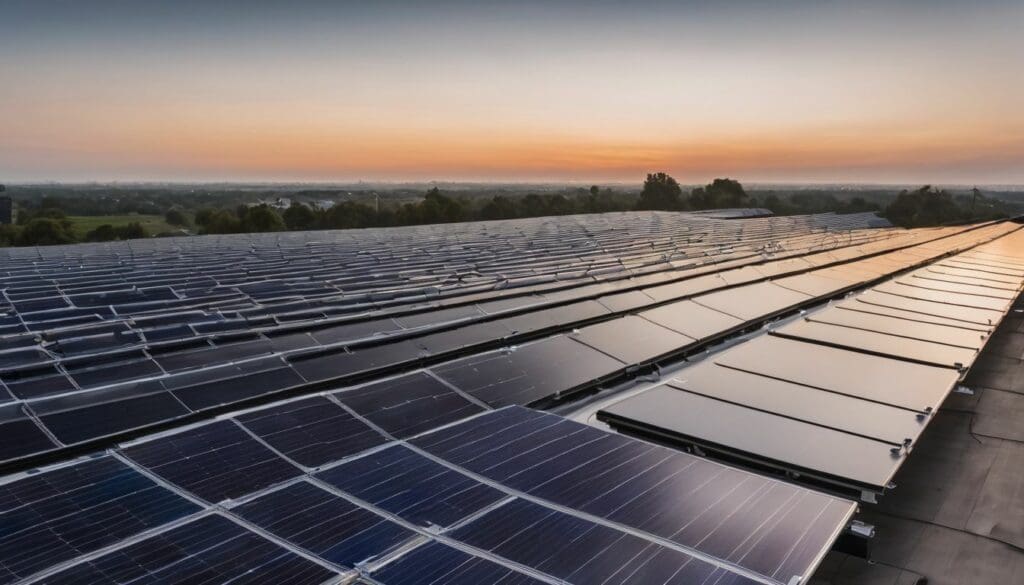As businesses feel the pressure to go green, many are stumped on where to start. The transition to renewable energy can cut operational costs significantly. Our guide will lay out clear steps for your company to establish a robust green energy policy, starting today.
Let’s create change together.
Key Takeaways
- Implementing a green energy policy can significantly reduce operational costs and protect against fluctuating energy prices.
- A thorough sustainability audit is the first step in identifying potential improvements and integrating renewable energy solutions into your business operations.
- Setting clear, achievable renewable energy goals helps to track progress and aligns with overall business objectives for a sustainable future.
- Seeking expert assistance can guide you through complex renewable options, financial incentives, and practical implementation within your industry sector.
- Regularly monitoring the performance of implemented green policies ensures they remain effective, helping to achieve carbon-neutral status while reducing environmental impact.
Importance of a Green Energy Policy
Implementing a green energy policy in your business can lead to lower costs, increased employee productivity, and boost innovation and creativity. Additionally, it has a positive impact on the environment by reducing carbon footprint and promoting sustainable practices.
Lower costs
Switching to green energy can slash your business’s utility bills significantly. By adopting renewable energy sources such as solar or wind power, you’re not just generating your own electricity but also protecting against fluctuating energy prices.
This transition might require an initial investment, but the long-term savings on operational costs are considerable. Solar panels and wind turbines eventually pay for themselves through lower monthly expenses.
Energy efficiency measures go hand in hand with sustainable energy policy. Upgrading lighting systems to LEDs, improving insulation, or installing smart thermostats reduces the amount of energy needed to run your business day-to-day.
These improvements lead to substantial savings on heating and cooling costs throughout the year. Plus, many regions offer incentives for businesses that implement ecofriendly initiatives which can further offset initial upgrade expenses.
Your commitment to environmental responsibility not only helps the planet but also strengthens your bottom line by decreasing ongoing expenditures related to power consumption.
Increased employee productivity
Implementing a green energy policy can lead to increased employee productivity, as it creates a healthier and more comfortable work environment. By prioritising clean energy sources and energy efficiency measures, businesses can reduce indoor air pollution and improve overall air quality within the workplace.
This can result in fewer sick days for employees due to respiratory issues, leading to higher attendance rates and improved focus on work tasks. Additionally, integrating natural lighting and sustainable building designs can enhance the morale of employees, contributing to a more positive and productive workforce.
Furthermore, offering eco-friendly initiatives such as flexible working hours or remote working options demonstrates an employer’s commitment to environmental responsibility, which can motivate employees to be more engaged and committed in their roles.
Boost innovation and creativity
Increased employee productivity creates a conducive environment for fostering innovation and creativity within the workplace. By prioritising green energy policies, businesses can inspire their employees to think creatively about sustainable solutions.
This forward-thinking approach not only benefits the company but also contributes to positive environmental outcomes, aligning with corporate sustainability efforts. Embracing clean energy implementation leads to a culture of innovation, enabling the development of eco-friendly energy solutions that reduce carbon footprints while fulfilling renewable energy sourcing goals.
The integration of renewable energy adoption and green technology inspires employees to contribute ideas that support climate change mitigation and environmental responsibility in business practices.
Positive impact on the environment
Implementing a green energy policy not only boosts innovation and creativity but also has a positive impact on the environment. By transitioning to renewable energy sourcing options like solar, wind, and bioenergy, businesses can significantly reduce their carbon footprint.
This shift towards eco-friendly energy solutions plays a crucial role in supporting conservation and environmental sustainability, aligning with corporate sustainability initiatives and clean energy solutions.
By integrating sustainable business practices such as fuel cells and waste heat recovery into their energy strategy, businesses contribute to carbon-neutral business practices while actively reducing their environmental impact.
Steps to Implement a Green Energy Policy
Conduct a sustainability audit, set renewable energy goals, seek expert assistance, determine feasibility of options, develop a plan and implement and monitor. To learn more about implementing a green energy policy in your business, keep reading!
Conduct a sustainability audit
To implement a green energy policy, begin by conducting a sustainability audit. This involves evaluating your current energy usage and identifying areas for improvement. Assess the environmental impact of your operations, measure resource consumption, and identify opportunities for energy efficiency and renewable energy integration.
By conducting this audit, you can gain valuable insights into your carbon footprint and pinpoint where eco-friendly practices can be implemented to reduce it.
This thorough examination will help determine the most effective strategies for reducing energy consumption, lowering costs, and transitioning towards eco-friendly alternatives. Utilise the findings from the sustainability audit to inform decisions on renewable energy sourcing strategy, clean energy solutions, carbon-neutral business practices, as well as green technology integration within your business operations.
Set renewable energy goals
Establish clear and achievable renewable energy goals to guide your business towards a greener future. By defining specific targets for transitioning to clean energy sources, such as solar or wind power, you can track progress and motivate your team to actively work towards a sustainable operation.
Aligning these goals with your overall business objectives will strengthen your commitment to reducing carbon emissions and fostering environmental stewardship within the company.
Ensure that your renewable energy goals are measurable and realistic, taking into account factors such as available resources, financial capacity, and regulatory considerations. Incorporating these benchmarks into your broader sustainability strategy will demonstrate genuine dedication to eco-friendly practices while inspiring others in the industry to do the same.
Seek expert assistance
Implementing a green energy policy in your business warrants seeking expert assistance to ensure successful integration of eco-friendly energy solutions. Expert guidance can help navigate the complex landscape of renewable energy options and determine the most viable and effective strategies for your specific business needs.
Furthermore, their knowledge of financing options such as government subsidies and corporate PPAs can aid in making clean energy investment a reality for your company.
Understanding the importance of green energy is crucial, but it’s equally vital to have specialised support when navigating this critical transition towards sustainable practices. Next, let’s delve into understanding different types of renewable energy options available for businesses looking to go green.
Determine feasibility of options
Before implementing a green energy policy, it’s crucial to determine the feasibility of available options. Consider conducting an energy audit to assess current usage and identify potential areas for improvement.
Explore eco-friendly energy solutions such as solar, wind, bioenergy, or waste heat recovery, weighing their suitability for your business. Evaluate the financial implications and environmental impact of each option to make an informed decision on which renewable energy sources align with your sustainability goals and budget.
Once you’ve sought expert assistance in identifying potential renewable energy options for your business, take the next step by determining their feasibility through thorough assessment and consideration of various factors.
Develop a plan
To implement a green energy policy, it’s essential to develop a detailed plan. Start by conducting a sustainability audit to understand your current energy usage and identify areas for improvement.
Next, set clear renewable energy goals that align with the vision of becoming carbon-neutral. Seek expert assistance from professionals who can provide valuable insights and guidance on eco-friendly energy solutions.
Once you have established your objectives, determine the feasibility of different renewable energy options such as solar energy, wind power, or waste heat recovery systems. Finally, create a comprehensive plan detailing how you will implement and monitor the progress of your green energy policy.
Implement and monitor
Once a plan is in place, it’s essential to put it into action and keep a close eye on its progress. Implement the renewable energy solutions and regularly monitor their performance.
This involves tracking energy consumption, analysing data, and identifying areas for improvement. Regular assessments will ensure that the green energy policy remains effective and aligns with your business goals.
It’s crucial to remain proactive in making adjustments as needed to maximise the benefits of eco-friendly energy solutions while minimising environmental impact.
Types of Renewable Energy Options
Explore various renewable energy options such as solar energy, bioenergy, cooling and heating options, waste heat recovery, hybrid storage, energy analytics, wind energy, and IRECs to find the best fit for your business’s green energy policy.
Solar energy
Solar energy offers a sustainable solution for businesses looking to reduce their carbon footprint and reliance on non-renewable sources. Implementing solar panels can significantly lower energy costs while contributing to a greener environment.
By harnessing the power of sunlight, businesses can take advantage of government subsidies and green loans to invest in eco-friendly energy solutions.
Incorporating solar energy into your business not only demonstrates a commitment to environmental conservation but also aligns with carbon-neutral practices, making it an appealing investment for companies focused on sustainable growth.
Bioenergy
Bioenergy, derived from organic matter like plants and animal waste, offers a sustainable source of power. It involves the conversion of biomass into electricity or heat, reducing reliance on non-renewable energy sources.
Embracing bioenergy contributes to eco-friendly energy solutions and promotes carbon-neutral business practices. This renewable energy option aligns with green energy investment by offering an environmentally conscious approach that is beneficial for businesses looking to support conservation and environmental sustainability.
Businesses can integrate bioenergy into their operations through anaerobic digestion, combustion, or gasification technologies. These methods generate clean energy while effectively managing organic waste materials.
Cooling and heating options
To provide a green energy environment, explore sustainable cooling and heating options. Consider installing energy-efficient HVAC systems which reduce carbon emissions. Additionally, utilising geothermal heat pumps can significantly lower energy consumption while maintaining comfortable indoor temperatures.
Investing in smart thermostats and efficient insulation further supports your business’s carbon-neutral practices.
Consider waste heat recovery systems to harness excess thermal energy from industrial processes for space heating or water-heating purposes. This can lead to cost savings while reducing the environmental impact of your business operations.
Waste heat recovery
After considering cooling and heating options, businesses can also explore waste heat recovery to further enhance their green energy policy. Waste heat recovery involves capturing and reusing the excess heat generated during industrial processes, thus minimising energy wastage while reducing carbon emissions.
By implementing waste heat recovery solutions, businesses can contribute to eco-friendly energy solutions by maximising the use of available resources and adopting carbon-neutral business practices.
Incorporating waste heat recovery not only aligns with environmentally conscious initiatives but also offers an opportunity for businesses to demonstrate their commitment to supporting conservation and environmental sustainability.
Hybrid storage
Hybrid storage combines different forms of energy storage to provide a reliable and consistent power supply for your business. It maximises efficiency by utilising both short-term and long-term storage solutions, such as batteries and thermal energy storage.
This sustainable approach ensures that your business can access renewable energy effectively, while reducing costs and carbon emissions.
Choosing hybrid storage allows you to integrate various renewable sources into your energy supply mix, ensuring a stable and resilient green energy policy. By incorporating this eco-friendly solution, businesses can achieve carbon-neutral practices and contribute positively to environmental conservation efforts.
Energy analytics
Transitioning from hybrid storage to energy analytics, businesses can leverage cutting-edge technology and data analysis to optimise their green energy policies. Energy analytics involves the use of advanced software and tools to monitor, analyse, and manage energy consumption.
By collecting real-time data on energy usage, companies can identify inefficiencies and make informed decisions to reduce their carbon footprint. This proactive approach empowers businesses to track their progress towards sustainability goals and continuously improve their eco-friendly initiatives.
Implementing a robust energy analytics strategy enables organisations to pinpoint areas for improvement in resource utilisation, leading the way towards carbon-neutral business practices.
Wind energy
Wind energy is a sustainable power source harnessed by wind turbines to generate electricity. Utilising wind energy reduces reliance on fossil fuels, helping businesses transition towards eco-friendly energy solutions and carbon-neutral practices.
Implementing wind energy in your green policy can contribute significantly to reducing greenhouse gas emissions and combatting climate change, aligning with conservation and environmental efforts.
Businesses can access various financing options for integrating wind energy into their operations. Government subsidies, green loans, and corporate Power Purchase Agreements (PPAs) are viable avenues for securing financial support in the adoption of renewable energy sources like wind power.
IRECs
When considering renewable energy options for your business, it’s essential to explore innovative solutions such as International Renewable Energy Certificates (IRECs). IRECs represent the environmental attributes of a specific amount of renewable electricity generated and are a vital tool in supporting carbon-neutral business practices.
By purchasing IRECs, you can contribute directly to the growth of green energy infrastructure while offsetting your carbon footprint, aligning with eco-friendly energy solutions and demonstrating your commitment to conservation and environmental responsibility.
Incorporating IRECs into your green energy policy can enhance your company’s sustainability efforts by ensuring that the electricity used aligns with renewable sources, making a significant impact on reducing greenhouse gas emissions.
Financing Options for Renewable Energy
Government subsidies, green loans and corporate Power Purchase Agreements (PPAs) are popular financing options for businesses looking to invest in renewable energy. These options can help offset the initial costs and make the transition to sustainable energy more feasible for businesses of all sizes.
Government subsidies
Government subsidies provide financial support to businesses transitioning to renewable energy sources. These incentives help cover the initial costs of implementing eco-friendly energy solutions, making it more feasible for businesses to adopt carbon-neutral practices.
By taking advantage of government subsidies, companies can accelerate their shift towards sustainable energy while reducing their operational expenses.
These financial benefits not only ease the financial burden but also encourage businesses to embrace green energy initiatives, contributing positively to the environment and supporting conservation efforts.
Green loans
Businesses looking to invest in renewable energy solutions can consider green loans as a viable financing option. Green loans are specifically designed to fund eco-friendly projects, such as the installation of solar panels or other renewable energy systems.
By taking advantage of green loans, businesses can access affordable capital for their sustainability initiatives, allowing them to reduce their carbon footprint while also benefiting from long-term cost savings.
The availability of green loans presents an accessible and practical way for environmentally conscious businesses to transition towards eco-friendly energy solutions without compromising financial stability.
Corporate PPAs
Transitioning from financing options, another avenue for businesses to consider is Corporate Power Purchase Agreements (PPAs). This involves a long-term contract between a business and a renewable energy developer or provider.
Through PPAs, companies can directly purchase electricity generated from renewable sources such as solar or wind. By opting for Corporate PPAs, businesses can reduce their carbon footprint while also stabilising energy costs over the long term.
These agreements not only contribute towards eco-friendly energy solutions but also demonstrate a commitment to carbon-neutral business practices. Embracing Corporate PPAs aligns with the goal of implementing a green energy policy within an organisation and further contributes to promoting sustainability and environmental conservation.
Conclusion
In conclusion, implementing a green energy policy can bring numerous benefits to your business. Lowering costs, increasing productivity, and boosting innovation are just some of the positive impacts.
By taking proactive steps to implement renewable energy options and exploring financing opportunities, you can make a meaningful contribution to sustainable practices while also benefiting your bottom line.
Consider conducting a sustainability audit and seeking expert assistance to develop a plan that fits your business needs.
FAQs
1. What steps should I take to create a green energy policy for my business?
Begin by researching eco-friendly energy solutions and plan how your business can transition to these options, aiming for carbon-neutral practices.
2. Why is it important to have a green energy policy in my business?
Implementing a green energy policy reduces your environmental impact and demonstrates responsibility towards sustainable living, which customers value.
3. Can adopting a green energy policy save my business money in the long run?
Yes, although initial investments may be required, over time eco-friendly solutions typically lead to lower operating costs and potential financial savings.
4. How do employees fit into the implementation of a green energy policy?
Engage with your staff about the benefits of eco-friendly practices; their active participation is key for successfully moving towards more sustainable ways of working in your business.





